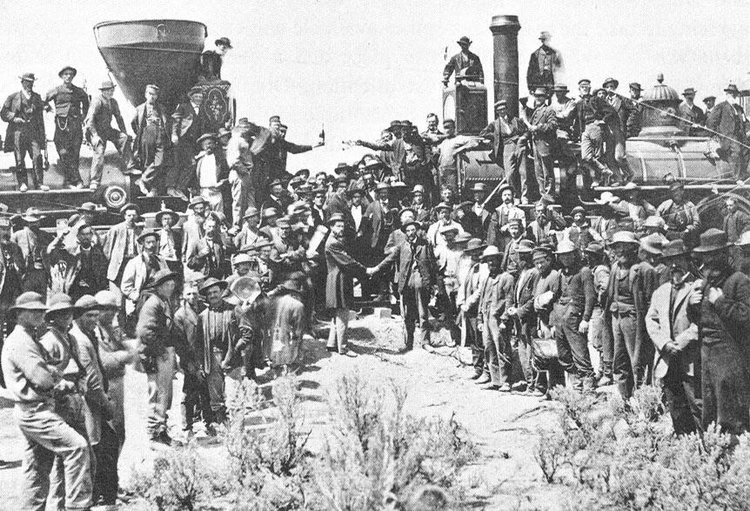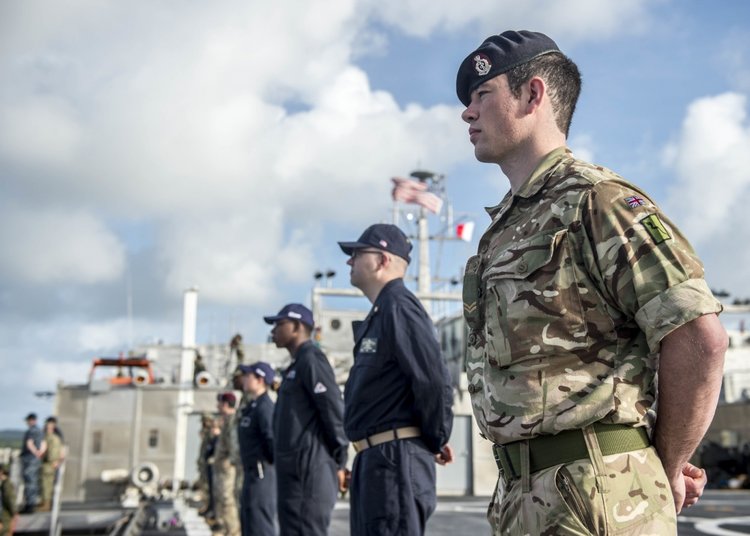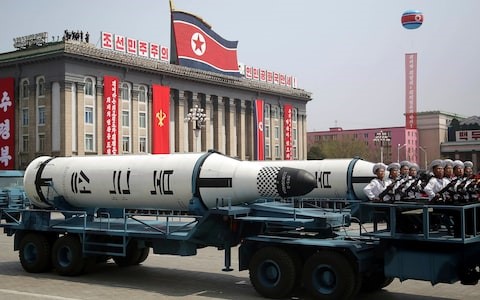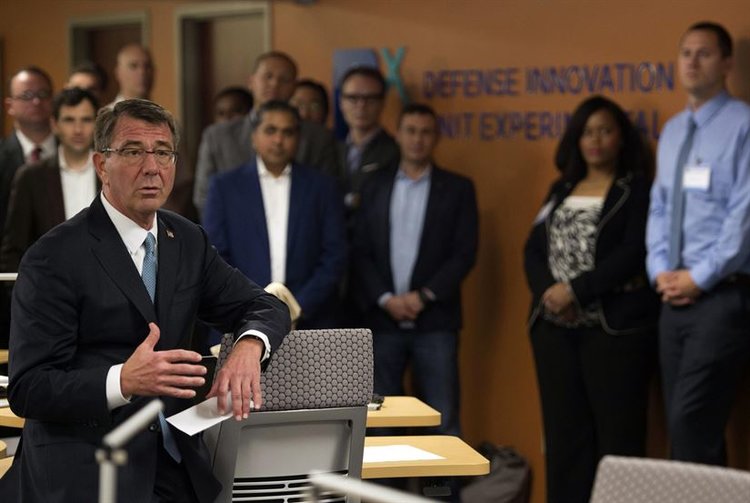Troy E. Mitchell
America’s military technological advantage is eroding, which degrades the ability of the Department of Defense to counter near-peer military advancement in the joint operating environment. While the U.S. has been involved in two protracted land wars since 2001, near-peer competitors such as Russia and China have been modernizing their militaries and developing and proliferating disruptive military capabilities across the spectrum of conflict to challenge the United States’ military power. Inter-service competitive pressures and innovation by defense contractors, intertwined with the differences in innovation spending between defense contractors and technology giants, demonstrate aspects of innovation erosion, a consequence of the competing pressures to maintain the United States’ technological edge and military dominance.
Russia and China may not offer the world’s best technology. Their ability to harness cost-efficient industrial bases and supply chains, however, provides them a competitive advantage in the international arms market, creating the potential to offset the U.S. military’s technological advantage through acquisition efficiencies and calculated risk. The result is the U.S. military and its allies face a new generation of lethal and competent adversaries emerging from what some have termed the fourth industrial revolution.[1] The fourth industrial revolution is defined by a range of new technologies fusing the physical, digital, and biological worlds, and impacting all disciplines, economies, and industries.[2]
As the U.S. military navigates the fourth industrial revolution, the focus of acquisition should enable employing forward postured military forces in a joint operating environment to meet national interest requirements with competitive technological resources. This article provides an overview of the industrial revolutions that led to the adaptations of military strategy in modern warfare, while highlighting concerns of integrating new capabilities of the fourth industrial revolution found in the commercial sector to avoid an eroding technological military force.
THE INDUSTRIAL REVOLUTIONS

The ceremony commemorating the driving of the golden spike on the first transcontinental railroad in North America, May 10, 1869. (Andrew J. Russell/Wikimedia)
The first industrial revolution centered on new manufacturing processes in the 18th and 19th centuries in Europe and America, which transitioned from hand production to machines, new chemical manufacturing and iron production processes, the increasing use of steam power, and the development of machine tools.[3] During the first industrial revolution, military firepower became vastly more effective due to the adoption of rifles and breech loading weapons. The second industrial revolution occurred between 1870 and 1945, during a period of growth for pre-existing industries, such as steel, oil and electricity, paving the way for the progression of electric power for mass production.[4] Where the second industrial revolution differed was in the development of the railroad to transport raw materials. Great innovations during this time period included the airplane, the tank, poison gas, and the submarine. The third industrial revolution occurred between the 1980s and early 2000s. This period advanced technology from analog electronic and mechanical devices to digital technology.[5] Significant developments of the third industrial revolution were the personal computer, the internet, and information and communications technologies. Modern society is now in the fourth industrial revolution, comprising the development of artificial intelligence, robotics, the so-called Internet of Things, autonomous vehicles, additive manufacturing (i.e., 3D printing), quantum computing, and nanotechnology.[6] In this period, morality and ethical issues draw concern from the push of a button capability, which provides opportunity to dehumanize warfare. As this revolution transpires, restraint in the employment of advanced technology supporting power projection must be acknowledged.
HISTORICAL SIGNIFICANCE
As the U.S. transitioned from various industrial revolutions, the acquisition of future weapons, intelligence assets, advanced technologies, and the use of information warfare serve as complementary systems supporting future warfare design. As the Germans learned in World War I, penetrating the defense was impossible without combining technology advancements to advance military tactics. Today, anti-access and area denial capabilities serve as a layered defensive system. The U.S. military exploitation concept employs forward deployed global forces to exploit adversarial gaps while harnessing the advancement in industrial revolutions.[7] Forward deployed, distributed forces provide security for other nations and protect against contingencies affecting vital U.S. interests.
In the Asia-Pacific, there are more than 154,000 active-duty military personnel (and another 176,000 civilians) prepositioned at 49 major bases located in Japan, South Korea, Australia, Singapore, Guam, the Marshall Islands, and the Northern Mariana Islands.[8] Moreover, deploying to the Asia-Pacific are five aircraft carrier strike groups, including as many as 180 ships and 1,500 aircraft, two-thirds of the Marine Corps’ combat strength, five Army Stryker brigades, and more than half of overall U.S. naval strength.[9]

Combined forces aboard the expeditionary fast transport ship USNS Brunswick man the rails as the ship arrives in Colonia, Micronesia, for the first stop of Pacific Partnership 2018. U.S. Navy Photo/Seaman Caledon Rabbipal)
These distributable forces need to be empowered, equipped, and trained with the capabilities to maneuver and leverage intelligence assets, fires, and information warfare wherever they are employed on the modern decentralized battlefield. The Heritage Foundation asserts that in supporting major combat operations, the contemporary battlefield:
...would feature a major opponent possessing modern integrated air defenses; naval power (surface and subsurface); advanced combat aircraft (to include bombers); a substantial inventory of short-range, medium-range, and long-range missiles; current-generation ground forces (tanks, armored vehicles, artillery, rockets, and anti-armor weaponry); cruise missiles; and (in some cases) nuclear weapons. Such a situation involving an actor capable of threatening vital national interests would present a challenge that is comprehensively different from the challenges that the U.S. Joint Force has faced in past decades.[10]
Success in war is partly a function of matching the tools of warfare to a specific task and employing those tools effectively in the conditions of the battle.[11] The U.S. military’s context for combined arms has changed from integrating firepower and mobility to the employment of intelligence assets, information warfare, electronic warfare, surface, and ground fires to facilitate maneuver. This change is neither subtle nor gradual, but immediate and necessary for survival on the modern battlefield. For example, Russia seeks to restore its great power status by reinvesting in military capabilities and modernized forms of subversion enabled by cyber capabilities that create an unstable Eurasia.[12]
Meanwhile, North Korea’s weapons of mass destruction program, public threats, defiance of the international community, confrontational military posturing, and cyber activities “pose a complex and increasingly grave national security threat.”[13] Additionally, Iran continues to develop nuclear capable missiles, sponsor terrorism, and leading regional proxy wars that threaten the U.S. and its partners. The U.S. military must ensure that, regardless of employment, distributable forces mass fourth industrial revolution technological effects to exploit the adversary’s system and distribute and concentrate effects on the modern-day battlefield.[14]

A submarine missile is paraded across Kim Il Sung Square during a military parade in Pyongyang, North Korea, in 2017. (AP Photo)
NAVIGATING THE FOURTH INDUSTRIAL REVOLUTION
The U.S. military innovation can advance in five key areas found in the fourth industrial revolution: autonomous learning systems, human-machine collaborative decision-making, assisted human operations, advanced manned-unmanned systems operations, and network-enabled autonomous weapons and high-speed projectiles.[15] Autonomous systems are critical to current and future Department of Defense missions, accomplishing goals independently, or with minimal supervision from human operators in environments that are complex and unpredictable.[16] For example, the U.S. Army Robotics and Autonomous Systems strategy report for 2015-2040 identifies a range of capability objectives, including enhanced situational awareness, cognitive workload reduction, force protection, cyber defense, logistics, etc, that rely on autonomous systems and higher levels of autonomy.[17]
To aid in combating adversary systems and decreasing cognitive workload, human-machine collaborative decision-making complement the strengths of a human and a computer to create better solutions to a large-scale, complex problem.[18] Assisted human operations include wearable electronics, combat applications, heads-up displays, and exoskeletons helping service members in contingencies. The Air Force Research Lab is designing skin biosensors that look and feel like a Bandaid, except the biosensors are equipped to read data like heart rate, hydration, and other vital signs.[19] Advancements in these areas boost military capabilities past near-peer competitors and allow the development of new capabilities beyond the current and projected ability of competitors and adversaries.

Then-Defense Secretary Ash Carter speaks with Defense Innovation Unit Experimental employees. (USAF Photo/SMSgt Adrian Cadiz)
By acknowledging the five innovative areas, the Department of Defense must identify how to integrate the new capabilities under the Department of Defense. For the Department of Defense to identify and acquire new and innovative capabilities from the commercial sector, there are four requirements.[20] First, there is a need to develop problem statements allowing the clear understanding of the required capabilities. Second, a clear demand signal should be sent to industry. Third, the Department of Defense and industry should concur with product availability and options. Fourth, the industry must be presented with sufficient incentives to convince firms that working with the Department of Defense supports their business interests. Although some of these components exist, the latter may not.
The U.S. military remains superior to its competitors and potential adversaries with respect to size, global engagement, and technological capabilities. However, the state of U.S. defense innovation, despite its resilience and superiority, suffers from structural erosion in spite of the fourth industrial revolution. As a result, the Department of Defense potentially faces relative decline if not adapted for the modern, distributable force battlefield.
Troy E. Mitchell is an officer in the United States Marine Corps and a Featured Contributor for The Strategy Bridge. He currently serves as an exchange officer to the Australian Defence Force. The views expressed in this article are those of the author alone and do not represent the official position of the U.S. Marine Corps, the Department of the Navy, the Department of Defense, or the U.S. Government.
Header Image: his image shows the machine works of Richard Hartmann in Chemnitz. Hartmann was one of the most successful entrepreneurs and largest employers in the Kingdom of Saxony. (Wikimedia)
NOTES:
[1] Schwab, K. (2016). The Fourth Industrial Revolution. New York: Crown Business.
[2] Schwab, K. (14 January 2016). “The Fourth Industrial Revolution: what it means, how to respond.” World Economic Forum. Retrieved from https://www.weforum.org/agenda/2016/01/the-fourth-industrial-revolution-what-it-means-and-how-to-respond/
[3] Editors of Encyclopaedia Britannica (07 February 2018). “Industrial Revolution.” Encyclopaedia Britannica. Retrieved from https://www.britannica.com/event/Industrial-Revolution
[4] Richmond Vale Academy. (21 July 2016). Second Industrial Revolution: The Technological Revolution. Retrieved from http://richmondvale.org/second-industrial-revolution/
[5] The Economist. (21 April 2012). A third industrial revolution. Retrieved from https://www.economist.com/node/21552901
[6] Schwab, K. (2016).
[7] Harris, H.B., Brown, R. B., Swift, S. H., & Berry, ,R.D. (02 March 2018). “The Integrated Joint Force: A Lethal Solution for Ensuring Military Preeminence.” RealClear Defense. Retrieved from https://www.realcleardefense.com/articles/2018/03/02/a_lethal_solution_for_ensuring_military_preeminence_113139.html
[8] Lostumbo, M. J., et al. (2013). Overseas Basing of U.S. Military Forces: An Assessment of Relative Costs and Strategic Benefits. Santa Monica, CA: Rand Corporation, p. 20.
[9] Erickson, A. S. and Mikolay, J. D. (2015). “Guam and American Security in the Pacific,” in Rebalancing U.S. Forces: Basing and Forward Presence in the Asia-Pacific, ed. Carnes Lord and Andrew S. Erickson. Annapolis, MD: Naval Institute Press, p. 16.
[10] Heritage Foundation (2017). 2017 Index of U.S. Military Strength. Retrieved from https://index.heritage.org/military/2017/assessments/us-military-power/
[11] Ibid.
[12] National Security Strategy of the United States of America. (2017). Washington DC: The White House, pp.2-3.Retrieved from https://www.whitehouse.gov/wp-content/uploads/2017/12/NSS-Final-12-18-2017-0905.pdf
[13] Mitchell, T. E. (09 January 2018). “Challenging the Lion.” The Strategy Bridge. Retrieved from https://thestrategybridge.org/the-bridge/2018/1/9/challenging-the-lion
[14] Serena, C.C. & Clarke, C.P. (06 April 2016). “A New Kind of Battlefield Awaits the U.S. Military—Megacities.” RAND. Retrieved from https://www.rand.org/blog/2016/04/a-new-kind-of-battlefield-awaits-the-us-military-megacities.html
[15] Ellman, J., Samp, L. & Coll, G. (March 2017). Assessing the Third Offset Strategy. Washington DC: Center for Strategic & International Studies. Retrieved from https://csis-prod.s3.amazonaws.com/s3fs-public/publication/170302_Ellman_ThirdOffsetStrategySummary_Web.pdf?EXO1GwjFU22_Bkd5A.nx.fJXTKRDKbVR
[16] Neema, S. (n.d.). “Assured Autonomy.” DARPA. Retrieved from https://www.darpa.mil/program/assured-autonomy
[17] Maneuver, Aviation, and Soldier Division Army Capabilities Integration Center. (March 2017). “Robotics and Autonomous Systems Strategy.” TRADOC. Retrieved from http://www.tradoc.army.mil/FrontPageContent/Docs/RAS_Strategy.pdf
[18] Malasky, J. S. (23 June 2005). “Human Machine Collaborative Decision Making in a Complex Optimization System.” MIT. Retrieved from https://dspace.mit.edu/bitstream/handle/1721.1/32514/62075059-MIT.pdf;sequence=2
[19] Lange, K. (30 March 2016). “3rd Offset Strategy 101: What It Is, What the Tech Focuses Are.” DoDLive. Retrieved from http://www.dodlive.mil/2016/03/30/3rd-offset-strategy-101-what-it-is-what-the-tech-focuses-are/
[20] Ellman, J., Samp, L. & Coll, G. (March 2017)
No comments:
Post a Comment